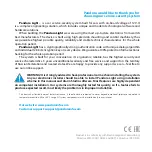
- 3 -
Add the telephone numbers of the local emergency service provider and a qualified
technician to the self-adhesive labels provided. Place one label next to the monitor,
and the other label near a source of fresh air where you plan to gather when the carbon
monoxide monitor signals are activated.
After installation is completed,
TEST
the monitor by pressing the
TEST/RESET/MUTE
button for at least 2 seconds. Detailed testing instructions are outlined in Section 9.
DO NOT TRY TO TEST THIS MONITOR IN ANY OTHER WAY:
If no alarm sounds, or
low or erratic sound emits from the monitor during a test, the unit may be defective and
should be returned for service. (See Section 13)
CLEANING THE MONITOR
: You can clean the monitor by using a vacuum cleaner
brush to vacuum around the openings on the monitor. The outside of the monitor may
be wiped with a cloth slightly dampened with water only
.
After cleaning, confirm that the
POWER
green LED flashes once every 60 seconds (see Operation in Section 8), and
test the monitor by operating the
TEST/RESET/MUTE
button
.
DO NOT PAINT ON OR NEAR THE MONITOR:
The paint will damage the sensor or
block the vents and affect the monitor function.
DO NOT SPRAY AIR REFRESHENER, CLEANING SUPPLIES, OR INSECT KILLER
ON OR NEAR THE MONITOR:
Certain kinds of aerosol chemicals will damage the
sensor and cause improper operation. The dwelling must be well ventilated when using
cleaning supplies or similar contaminants.
2. WARNING MESSAGES
WARNING!
Actuation of this device indicates the presence of carbon
monoxide (CO) which can KILL YOU.
WARNING!
Test the CO monitor at least once a week
WARNING!
Test the CO monitor immediately after the residence or
facility has been vacant.
WARNING!
The loudness of the alarm sound may cause you to feel
uncomfortable. Cover the horn opening with the palm of your hand to reduce the
volume while testing the monitor.
WARNING!
Constant exposure to high or low temperature, or high
humidity, may shorten battery life.
!
!
!
!
!




































